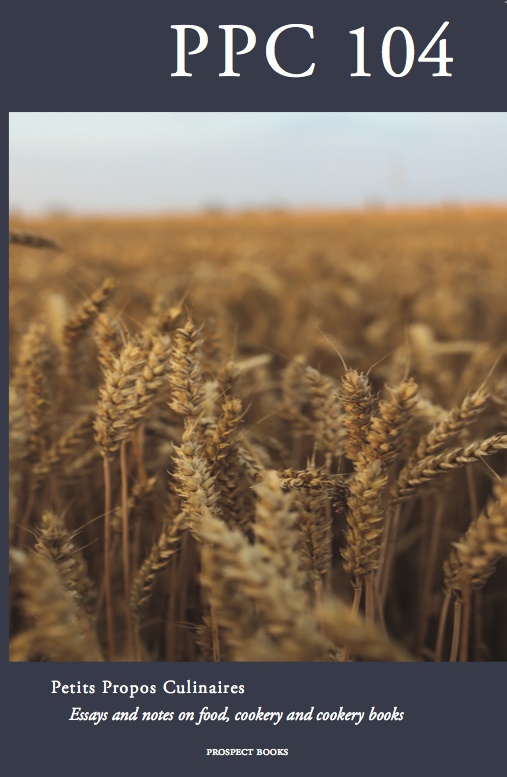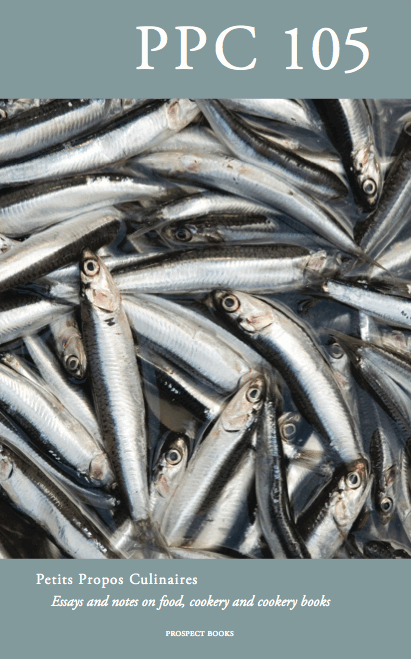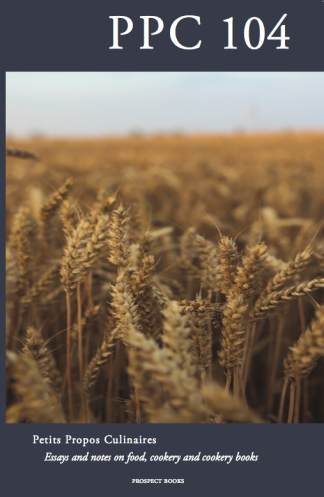Description
Contents49Tarhana and Keşkek: Origins and AffiliationsAhmet Uhri
|
A taster from Tarhana and Keşkek: Origins and Affiliations by Ahmet Uhri
The origin of tarhana is a topic much visited in earlier issues of this journal. The piece which follows, by a Turkish scholar of Hittite civilization, proposes a much earlier genesis than previous contributors. For those readers as unversed as the Editor in such matters, I repeat here the definitions of tarhana and keşkek that can be found in the Oxford Companion to Food. Tarhana ‘or trahana(s) [is] a family of grain products, extending from Iran to the Balkans and Hungary. The basic recipe is crushed wheat mixed with yoghurt, allowed to rest and sour up to seven days and then formed into sheets or pellets which are dried in the sun. These … are crumbled at some point before use. The usual destination is soup, but it is also eaten by itself as a sort of pilaf, and often with crumbled cheese as a sort of breakfast cereal.’ Keşkek or kashk occurs ‘in several different cultural areas – Iran, Iraq, Greater Syria, Egypt, south Caucasia and Turkey. … Nowadays it is … a preserved food made from wheat and/or barley mixed with either sour milk or yoghurt. It can also mean a dish in which kashk or kishk is mixed with vegetables and/or meat; or it can mean dried yoghurt/buttermilk/curds on their own. In the wheat-growing areas of Lebanon, Syria, Turkey, and Armenia kishk is the name usually given to a preserved food made of yoghurt and burghul.’A culinary dish is usually defined by how the natural products contained within it are transformed. Food that is consumed without transformation is mere nourishment, it is not cooking. However, food may be transformed by more than just cooking, most importantly by the ecosystem in which it subsists. The ecosystem consists of biotic and abiotic factors. Abiotic factors are directly dependent on the geological structure of the environment, and they contain inorganic sub-factors such as the water, air and climate that make that environment habitable. Biotic factors are related to living beings. These may be subdivided into producers, consumers and decomposers. In brief, it is not possible to understand how mankind produces food without being aware of the relations between living beings and the ecosystem, as well as their mutual relations with other living beings within the same environment.
One might ask what has all this got to do with tarhana? The answer relates to south-west Asia at the end of the Younger Dryas (ca. 11,000 bc), or the Big Freeze, when the climate gradually stabilized. In short, when abiotic factors fell into place, so too the foundations of modern times were laid. The civilization built on these foundations cultivated grain – this region is the homeland of domesticated wheat and barley. Surely, it would not be wrong to assume that the fauna of this region must have been as rich as its flora. Sheep, goats, deer, various bird species and other living beings found habitats in different niches of this ecosystem. Land lying 600–800 metres above sea level can be defined as one of these ecological niches: in other words, the region to the south of the south-east Taurus Mountains, sloping down towards Mesopotamia. This restricted yet unitary zone tells one of the most interesting stories in the history of civilization. It is the story of mankind adopting a sedentary lifestyle and beginning to practice agriculture. The first temples and many other indicators of civilization occurred, matured and spread from this region, as did the cultivation of wheat, barley, and other cereals as well as plants, and the domestication of sheep, goats, cattle and other animals. In brief, the first village life in history occurred in this region and radically changed the nutritional habits of mankind. Before this process began (approximately 12,000 years ago), food was obtained by hunting and collecting. It can be said that nutritional habits underwent a revolutionary turn when societies began to protect and store their products, and began to mix compatible foods to prepare a meal.1
Grinding grain or barley and preparing different types of dough and porridge; adding water to produce fermentative products, like beer from malt or boza from grain; the occurrence of milk and milk products as by-products of livestock breeding (the so-called ‘by-product revolution’ of archaeological jargon); these are all part of the culture that arose under the influence of the ecosystem of this region of south-west Asia. After all, culture in its broadest sense includes everything that is made by mankind rather than by nature. Therefore, the change in nutritional habits is actually a cultural change. One of the products that came about during this cultural shift is tarhana. It might seem daring, but the evidence and arguments presented below indicate that it is possible to trace the origins of tarhana back to prehistoric times. This suggestion is based on archaeobotanical, archaeozoological and archaeometrical data with respect to prehistory, and on the first scripts found in Mesopotamia and Anatolia with respect to historical times.
Where tarhana is concerned, a search of the literature reveals that most discussion revolves around whether tarhana was invented by a Byzantine-Roman-Greek triad or whether it was the product of the Iranian (i.e. Persian) highlands.2 Since most of those writing on this topic are historians, their discussion rarely looks further into the past than evidence provided by Greek, Roman and Byzantine sources. However, a look at studies of archaeological data and evidence from earlier linguistic sources shows that we might locate the origins of tarhana further back in time. This might seem somewhat far-fetched, but I think that European historians may suffer here from an overly Euro-centric point of view and occult prejudice. Whenever they contemplate the Near East, unless they are archaeologists or oriental linguists, history begins with the Greeks and Romans, continues to Byzantium and reconnects to Europe via the Renaissance. Perforce, the Arabs are included in this overarching structure since it was they who made the bridge from classical to modern.
One might ask what has all this got to do with tarhana? The answer relates to south-west Asia at the end of the Younger Dryas (ca. 11,000 bc), or the Big Freeze, when the climate gradually stabilized. In short, when abiotic factors fell into place, so too the foundations of modern times were laid. The civilization built on these foundations cultivated grain – this region is the homeland of domesticated wheat and barley. Surely, it would not be wrong to assume that the fauna of this region must have been as rich as its flora. Sheep, goats, deer, various bird species and other living beings found habitats in different niches of this ecosystem. Land lying 600–800 metres above sea level can be defined as one of these ecological niches: in other words, the region to the south of the south-east Taurus Mountains, sloping down towards Mesopotamia. This restricted yet unitary zone tells one of the most interesting stories in the history of civilization. It is the story of mankind adopting a sedentary lifestyle and beginning to practice agriculture. The first temples and many other indicators of civilization occurred, matured and spread from this region, as did the cultivation of wheat, barley, and other cereals as well as plants, and the domestication of sheep, goats, cattle and other animals. In brief, the first village life in history occurred in this region and radically changed the nutritional habits of mankind. Before this process began (approximately 12,000 years ago), food was obtained by hunting and collecting. It can be said that nutritional habits underwent a revolutionary turn when societies began to protect and store their products, and began to mix compatible foods to prepare a meal.1
Grinding grain or barley and preparing different types of dough and porridge; adding water to produce fermentative products, like beer from malt or boza from grain; the occurrence of milk and milk products as by-products of livestock breeding (the so-called ‘by-product revolution’ of archaeological jargon); these are all part of the culture that arose under the influence of the ecosystem of this region of south-west Asia. After all, culture in its broadest sense includes everything that is made by mankind rather than by nature. Therefore, the change in nutritional habits is actually a cultural change. One of the products that came about during this cultural shift is tarhana. It might seem daring, but the evidence and arguments presented below indicate that it is possible to trace the origins of tarhana back to prehistoric times. This suggestion is based on archaeobotanical, archaeozoological and archaeometrical data with respect to prehistory, and on the first scripts found in Mesopotamia and Anatolia with respect to historical times.
Where tarhana is concerned, a search of the literature reveals that most discussion revolves around whether tarhana was invented by a Byzantine-Roman-Greek triad or whether it was the product of the Iranian (i.e. Persian) highlands.2 Since most of those writing on this topic are historians, their discussion rarely looks further into the past than evidence provided by Greek, Roman and Byzantine sources. However, a look at studies of archaeological data and evidence from earlier linguistic sources shows that we might locate the origins of tarhana further back in time. This might seem somewhat far-fetched, but I think that European historians may suffer here from an overly Euro-centric point of view and occult prejudice. Whenever they contemplate the Near East, unless they are archaeologists or oriental linguists, history begins with the Greeks and Romans, continues to Byzantium and reconnects to Europe via the Renaissance. Perforce, the Arabs are included in this overarching structure since it was they who made the bridge from classical to modern.



